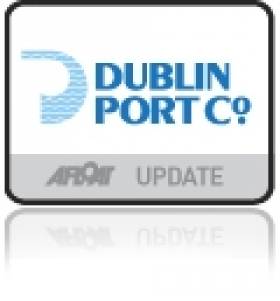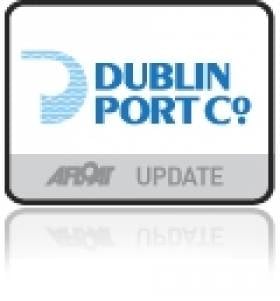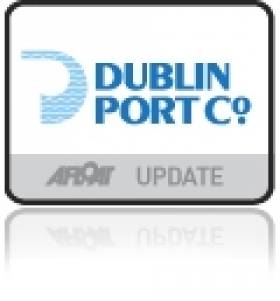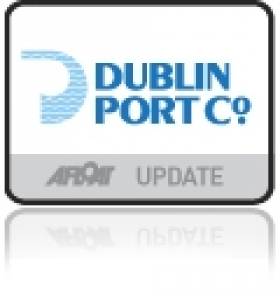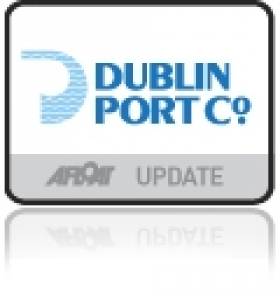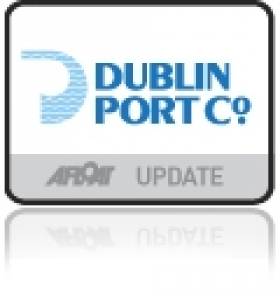Displaying items by tag: Dublin Port
Dublin Port's Diving Bell To Be Restored As Visitor Centre
#DublinPort - Dublin Port's 140-year-old diving bell is set to be restored as a tourist attraction, as the Irish Independent reports.
The diving bell was first used in construction of the capital's deep-water quays in 1871, allowing for water to be pumped out and air to be pumped in for workers to make the river bed level, acting like a mobile caisson.
It was last used in the building of quayside walls as recently as 1958, and following a campaign to save it from the scrapheap in the 1980s it was moved to its present location on Sir John Rogerson's Quay.
Now it will form the basis of a new interpretive centre to be readied this June, where visitors will be able to access the 90-tonne device from beneath and learn more about its fascinating history.
The Irish Independent has more on the story HERE.
More from Dublin Port Company:
Have you ever passed by the odd looking, bell-shaped, red metal structure standing tall on Sir John Rogerson's Quay and wondered what it is? You could be forgiven for thinking it is a modern art sculpture or misplaced mound of metal. It is in fact an ingenious feat of Irish engineering that was essential in building Dublin's quay walls for 87 years. This is Dublin Port's "Diving Bell".
Dublin Port Company today announced a new project that will shed light on this important artefact and will transform the Diving Bell into a new interpretive exhibition that explains its origin and history.
The Diving Bell was designed by the port engineer Bindon Blood Stoney (1828 to 1907) and built by Grendon and Co., Drogheda. It was delivered to the Port in 1866, entered service in 1871 and was used in the building of the Port's quay walls until 1958. Stoney was a prodigious engineer and among his achievements were the building of the Boyne Viaduct in Drogheda, the construction of O'Connell Bridge and the building of many of the Port's quay walls including Sir John Rogerson's Quay and North Wall Quay Extension.
The Diving Bell was used in the building of the Port's quay walls from the Victorian era right up until almost the 1960s. It was a ground-breaking piece of engineering innovation in its day.
Its lower section was hollow and bottomless, providing just enough room for six men to work at a time. Once lowered into position on the riverbed, the crew entered through an access funnel from the surface and compressed air was fed in from an adjacent barge. The men inside the bell worked on the river bed exposed at their feet, excavating the site where a massive concrete block would later go; all the excavated soil was stashed in trays hanging inside the bell, and brought up when the bell was lifted.
The project, which commences this week and opens in mid-June 2015, will elevate the 13m tall, 90 tonne Diving Bell onto a two metre steel structure, creating a ramped public access route underneath. A water feature will also be installed beneath the structure accompanied by a series of interpretative panels explaining the historical, social and engineering significance of the Diving Bell. The new exhibition will be illuminated at night time using energy efficient LED lighting.
The project has been designed with the expertise of a range of people including the architect Sean O'Laoire, the sculptor Vivienne Roche, Tom Cosgrave (professor of engineering at the University of Limerick) and Mary Mulvihill of Ingenious Ireland.
This is the first project in Dublin Port's plan to create a 'distributed museum' of attractions across the Dublin docklands and into Dublin Port to preserve the port's industrial heritage and history.
Weslin Construction Ltd. has been appointed to carry out the project, which will be completed by mid-June 2015, when the newly reconfigured Diving Bell will open again to the city.
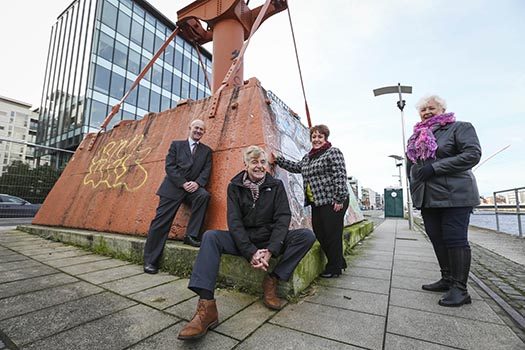
Pictured at the announcement are: Eamonn O'Reilly, Chief Executive, Dublin Port Company, Sean O'Laoire, Director of MOLA Architecture, Dolores Wilson, St. Andrews Resource Centre and Betty Ashe, St. Andrews Resource Centre
Eamonn O'Reilly, Chief Executive, Dublin Port Company said: "The Diving Bell is a remarkable feat of Irish engineering and Dublin Port Company is proud to invest in its transformation and bring the history of this magnificent structure to life along the Liffey. True to the commitment in our Masterplan, we are working to better integrate Dublin Port and the city. Developing the Diving Bell is the first step in our plan to create a distributed museum of port and industrial heritage attractions across the Dublin docklands and into the port. We are confident that the Diving Bell will give Dubliners and visitors to the city a true sense of Dublin as a port city with a wealth of industrial heritage to discover."
Betty Ashe of St. Andrew's Resource Centre, Pearse Street, said: "I am delighted that the next phase of the Diving Bell Project is now underway, having been involved in a Millennium project with St. Andrew's Resource Centre, the DDDA and Dublin Port Company to save and restore this fascinating artefact from the Victorian era. As a port community, we have a duty to preserve local history for future generations. I thank Dublin Port Company for sharing that vision and giving the Diving Bell a prominent place in the history books for this community and our city."
Dublin Port Company Opens New Alexandra Quay Container Terminal
#dublinport – Dublin Port Company today officially opened its newly completed Alexandra Quay Container Terminal following a €35m investment. The opening was welcomed by The Minister for Transport, Tourism and Sport, Paschal Donohoe, T.D.
The opening marks the completion of the third and final phase of the development of the new facility. This third phase will enable the terminal to cater for an additional 80,000 TEUs (twenty foot equivalent units) per annum bringing the terminal's total capacity to over 400,000 TEU per annum.
The initial two phases of the project created new runways for three rows of rubber tyred gantry cranes (RTGs), a type of large mobile crane used for stacking shipping containers.
The third and final phase added a fourth runway for RTGs and deepened and strengthened the quay wall to allow bigger container ships to be loaded and discharged with modern high speed ship-to-shore gantry cranes.
The terminal's operator, Burke Shipping Group, has invested in a new seventh RTG and will take delivery of a ship-to-shore gantry crane later in the year. Both of these new cranes are being supplied by Liebherr of Killarney. The finished terminal has an area of 10.7 hectares and the completed development comes at a time when Dublin Port's full year trading figures show a 7% increase for 2014, equalling the record levels of 2007.
Minister for Transport, Tourism and Sport, Paschal Donohoe, TD, said: "I congratulate Dublin Port Company on the completion of the development of this new container terminal. The €35 million investment by Dublin Port Company is significant and represents a sustainable approach to planning for the long-term capacity and infrastructure needs of Dublin Port and its customers. The fact that trade levels for 2014 are on a par with 2007 is testament to the hard work and commitment of all at Dublin Port Company who are driving the company forward and ensuring that Dublin Port plays to its full strengths in delivering for our economy and for our continued growth and development."
Eamonn O'Reilly, Chief Executive, Dublin Port Company said: "Dublin Port Company is proud to open the newly completed Alexandra Quay Container Terminal today. We have invested €35 million to develop this facility so that Dublin Port can continue to facilitate growth in the economy and meet the needs of our customers and Dublin as a port city. This project is a clear example of how Dublin Port Company is finding innovative ways to address demand for increased capacity and modernised infrastructure using the port's existing footprint. I am confident that this timely and sustainable investment, delivered through a successful public private partnership, achieves this important objective for Dublin Port.
Lucy McCaffrey, Chairperson, Dublin Port Company said: "Dublin Port Company's Masterplan includes a commitment to use the port's existing lands to the greatest extent possible. This is a very tangible example of how Dublin Port Company is continuing to act on this commitment. The completion of the Alexandra Quay Container Terminal gives Dublin Port additional container handling capacity and more modern port infrastructure that will benefit not only the port, but its customers and the wider economy in the immediate future and for years to come."
Dog Sniffs Out Millions Of Contraband Cigarettes At Dublin Port
#DublinPort - Casey the sniffer dog has sniffed out a haul of over seven-and-a-half million contraband cigarettes at Dublin Port, as BreakingNews.ie reports.
The Revenue pooch detected the 'Manchester' brand cigarettes – worth some €3.5 million – in a shipping container that arrived from Belgium hidden under plastic and listed in the manifest as breakfast cereal.
Dublin Port Post 2014 As Record Year For Trade
#dublinport – Dublin Port Company today published trade statistics for 2014 which show a record year for trade at Dublin Port, with growth year-on-year of 7.0%. The stats follow a weekend interview with Dublin Port Company Chief Executive, Eamonn O'Reilly who mapped out the future for Ireland's major shipping port.
Total throughput for 2014 was 31 million gross tonnes with 7,108 ship arrivals in the year, bringing the port's activity back to the record levels of 2007.
Imports in 2014 were over 18 million gross tonnes, while exports exceeded 12 million gross tonnes, representing increases of 6.3% and 8.0% respectively on 2013 trade levels.
The recovery in the Port's trade has been export-led with volumes of exports 1.6 million gross tonnes greater than in 2007. On the import side there has been continuing recent growth (driven by improving domestic consumption) and this has pushed Dublin Port's overall volumes ahead to equal previous record levels of 31 million gross tonnes.
High levels of growth were recorded for trade vehicles, mostly new cars destined for dealerships around the country. The port received 81,169 trade vehicles in 2014, up 33.3% on the previous year. To accommodate the growing number of trade vehicles entering the port, Dublin Port opened a new €3.4 million 4.2 hectare trade car terminal at East Wall Road in October 2014. This new terminal can cater for 2,500 vehicles at a time.
There was particularly strong growth in the unitised modes with Ro-Ro trailers ahead by 7.9% and Dublin Port's Lo-Lo container businessahead by 9.4%. In 2014, the Ro-Ro sector achieved strong results with 821,876 units while Lo-Lo containers finished the year at 565,698 twenty foot equivalent units (TEU). The strong performance of the unitised business highlights Dublin Port as the island's port of choice for both Ro-Ro and Lo-Lo services.
SUMMARY OF TRADE STATISTICS
|
2014 |
2013 |
|
|
Throughput (‘000 gross tonnes) |
30,849 |
28,840 |
|
18,358 |
17,271 |
|
12,491 |
11,569 |
|
Ro-Ro (freight units) |
821,876 |
761,958 |
|
Lo-Lo (TEUs) |
565,698 |
516,872 |
|
Ferry Passengers |
1,710,275 |
1,607,987 |
|
Tourist Vehicles |
462,215 |
428,468 |
|
Trade Vehicles |
81,169 |
60,905 |
On the tourism side, 1.7 million ferry passengers travelled through the port in 2014, representing a 6.4% increase on last year and placing Dublin Port on a par with major airports including Cork and Shannon. In addition, 2014 was a strong year for the port's cruise business with 140,000 visitors on 86 cruise ships.
Eamonn O'Reilly, Chief Executive, Dublin Port Company, said: "2014 was an exceptional year for Dublin Port with a 7.0% increase in cargo volumes on top of the 3.0% we saw in 2013. The port is now back to the record levels of trade recorded in 2007 with every prospect of continued strong growth in the years ahead.
"During 2014, we saw strong increases right across our main business areas, from imports and exports to trade vehicle and ferry passenger numbers. We expect growth to continue into 2015, with importers and exporters choosing to do business through Dublin Port where they benefit from direct access and frequent services to their main markets.
"Dublin Port Company is committed to sustainable investment in port infrastructure and services including the longer, deeper berths envisaged in our Alexandra Basin Redevelopment Project. These will accommodate the larger ships of the future carrying increased cargo volumes and greater numbers of passengers. This type of investment will allow Dublin and the wider economy to prosper by ensuring that Dublin Port is ready to facilitate the future trading needs of its customers and the country as a whole.
"Having completed major investments during 2014 including the new €3.4 million trade car terminal and with the development of the Alexandra Quay Container Terminal nearing completion, we are looking forward during 2015 to commencing the Alexandra Basin Redevelopment Project which the EU is already supporting under its TEN-T infrastructure investment programme."
#DublinPort - Dublin Port's chief executive has moved to dispel criticism of the city's Docklands an entry point for tourists, coming after another bumper year for cruise traffic.
Speaking to Bobby Kerr on NewsTalk's Down to Business show yesterday (10 January), Eamon O'Reilly hailed the port's growth – 7% last year alone, with 5% growth expected in the coming year – and its welcoming of more than 140,000 passengers on board 86 cruise liners in 2014.
But he also brushed aside accusations that the industrial appearance of Dublin Port gives a poor impression to cruise visitors docking in the area.
"We built the business from nothing to 100 ships in 2013, 86 in 2014. If you're building any business, or any stream of business, you don't go out and spend huge amounts of money to build infrastructure," he said.
"You don't do that, you work with what you have, which is what we have done. So it's funny, we seem to get criticised for our own success."
Beyond the port, O'Reilly commented on the untapped potential of the Liffey quays for boat traffic and the industries that might support, though noted the dilemma that "as you try to do more with the Liffey, the bridges start to get in your way."
He also detailed plans for the future that include another bid to bring the Tall Ships back to the capital in 2019, as well as progress on the Alexandra Basin project to increase the port's capacity for bigger container and cruise ships, not to mention increased ferry traffic.
Poor Navigation Standards On Container Ship Grounded On Arklow Bank Says MCIB Report
#MCIB - Lack of adherence to standard navigation procedures led to the grounding of a German-owned container ship on the Arklow Bank in January this year, according to the official report into the incident.
As previously reported on Afloat.ie, the MV Arslan II - which was sailing to Belfast from Turkey with a 4,000mt cargo of steel products - was dry-docked at Dublin Port after damaging her rudder on the sandbank some six miles off the Wicklow coast on 14 January.
A familiar visitor to the Irish Sea for more than two decades, mostly under her former name Coastal Isle, the ship was held in Dublin for more than two months while investigators from the Maritime Casualty Investigation Board (MCIB) examined all aspects of the vessel and the circumstances surrounding her grounding.
Their report is highly critical of the management of the 89m cargo ship, noting among other things that a stability calculation was not prepared on departure from her first port of call at Ceuta on the Strait of Gibraltar. Neither were her departure drafts or freeboard recorded in the ship's official log.
Stability proved to be an issue on the voyage, with a copy of the plan in force at the time of the incident showing the master's concerns at the vessel's heavy rolling even in even Force 4 winds.
Weather forecasts of Force 6 to 7 winds prompted the ship's master to alter course on approach to the Arklow Bank in the Irish Sea, seeking shelter from the coast.
But via a combination of outdated charts and incorrect tide tables, over-reliance on GPS over visual navigation cues, and miscommunication between deck officers, the Arslan II passed the southern marker buoy on the wrong side and grounded on the south end of the sandbank.
The MCIB took the ship's master to task for failing to report the grounding incident to the Irish Coast Guard, instead chartering her own tug to tow the vessel to the nearest available port large enough to accommodate her, which was Dublin.
In addition, investigators discovered that this was the second grounding incident for the vessel, following an incident in Scottish waters on the Isle of Bute in July 2012.
The full MCIB report is available to download below.
First Self-Handling Stevedoring Licence Awarded by Dublin Port
#Self-Stevedoring - A cement business with a plant in Dublin Port has been awarded a port company licence to unload its own ships to cut costs, writes The Irish Times.
The first self-handling stevedoring licence issued by the port company is to the Irish cement producer Ecocem. The cement business has a manufacturing plant in the port and expects to use approximately 150,000 tonnes of imported granulated blast furnace slag, which it uses in its production process, next year.
Conor O'Riain, managing director of Ecocem Ireland, said that aside form being the first self-stevedoring licence awarded, it is also the first licence issued to a new stevedoring operator in some time.
In November last year, the Competition Authority completed an investigation into the Irish ports sector and said competition in the sector could be improved.
For more on this story The Irish Times reports.
Burke Shipping Group Invest in New RTG for Dublin Port Container Terminal
#NewGantryCrane – A new rubber tyre gantry crane (RGT) for Burke Shipping Group's container terminal in Dublin Port is currently been assembled and is due to be operational in a fortnight, writes Jehan Ashmore.
The investment by BSG in the quayside infrastructure is to facilitate growing demand and increase capacity at the container terminal located in Alexandra Basin.
The RTG was manufactured by Killarney based Liebherr Container Cranes. This brings to 7 the total of RTG's in operation coupled with 12 cranes representing a €30 million investment by BSG.
In addition to the group operates container terminals in Belfast, Cork and Foynes.
EU Programme Co-Funds Capacity Studies on Port of Dublin
#EUdublinport – According to INEA, almost €2.5 million will be co-funded from the EU TEN-T Programme for studies into the capacity development of the Port of Dublin.
The studies are to improve the freight traffic connection to the main rail and road axis linking Ireland to the UK and continental Europe.
The project covers a set of preparatory studies for the construction works of the Alexandra Basin Redevelopment (ABR) global project with the aim to increase the port's capacity and adapt it to customer needs, mainly in the freight sector.
After the completion of works the port will be able to accommodate larger ships and provide them with multipurpose berths for multiple transport modes.
The studies include planning, environmental impact assessment, hearings on the project, economic and financial assessment, preparation and application for all relevant permits, licenses and consents, as well as procurement of detailed design services and documentation for the construction phase.
The project was selected for EU funding with the assistance of external experts under the TEN-T Multi-Annual Call 2013, priority projects.
Its implementation will be monitored by INEA, the European Commission's Innovation and Networks Executive Agency.
The project is to be completed by the end of 2015. For more about the INEA click this LINK.
Dublin Bay Watch Gives Guarded Welcome to Dublin Port Plan
#DublinPortPlan - One of the groups which successfully campaigned against Dublin Port Company's plans to infill 52 acres of the bay, Dublin Bay Watch has welcomed new plans to expand the port on its existing land base.
However, the group has warned the plans to double the capacity of the port could have serious environmental impacts on EU protected habitats in the bay.
At an An Bord Pleanála hearing yesterday morning, Dublin Bay Watch said the current plan was a welcome departure from 40 years of " failed attempts" to infill parts of the bay.
A planning hearing has opened into Dublin Port plans to redevelop Alexandra Basin in the north Port area - the first part of the port company's "Masterplan 2012 to 2040".Dublin Port unveils plan for expansion. For more The Irish Times has a report HERE.


























